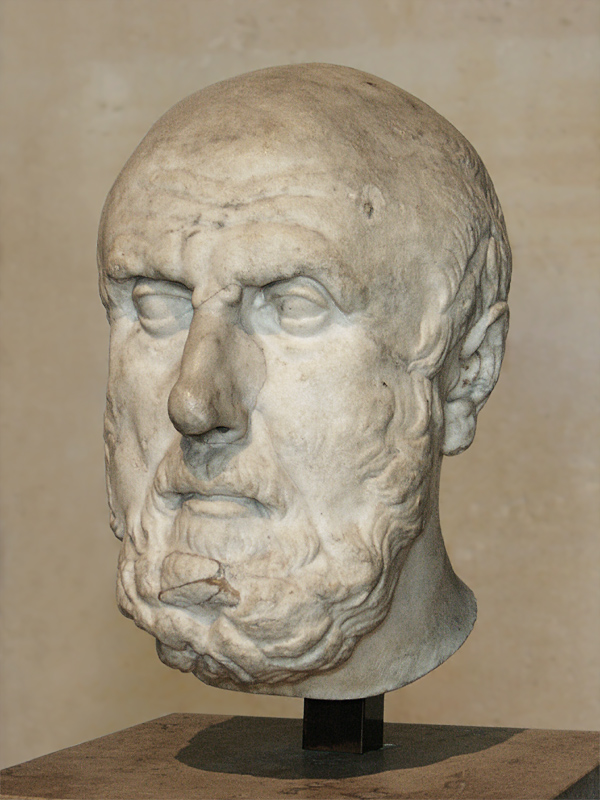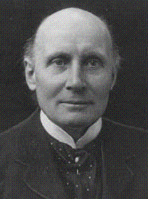- About MAA
- Membership
- MAA Publications
- Periodicals
- Blogs
- MAA Book Series
- MAA Press (an imprint of the AMS)
- MAA Notes
- MAA Reviews
- Mathematical Communication
- Information for Libraries
- Author Resources
- Advertise with MAA
- Meetings
- Competitions
- Programs
- Communities
- MAA Sections
- SIGMAA
- MAA Connect
- Students
- MAA Awards
- Awards Booklets
- Writing Awards
- Teaching Awards
- Service Awards
- Research Awards
- Lecture Awards
- Putnam Competition Individual and Team Winners
- D. E. Shaw Group AMC 8 Awards & Certificates
- Maryam Mirzakhani AMC 10 A Awards & Certificates
- Two Sigma AMC 10 B Awards & Certificates
- Jane Street AMC 12 A Awards & Certificates
- Akamai AMC 12 B Awards & Certificates
- High School Teachers
- News
You are here
Deduction through the Ages: A History of Truth
Introduction

Figure 1. This bust of Chrysippus of Soli, owned by the Louvre Museum, is believed to be a Second Century Roman copy of a Greek original. (Source: Wikimedia Commons, courtesy of Eric Gaba)
This curricular module offers excerpts from selected primary historical sources from antiquity to the twentieth century that illuminate the thought process of deduction encapsulated today as an implication in propositional logic. Beginning with five verbal argument forms attributed to the ancient Greek philosopher Chrysippus (280–206 BCE), the project examines the possible equivalence of these argument forms to a standard “if-then” statement (implication). The tools used to discuss these equivalences are the historical sources themselves. An initial attempt to render verbal statements to a symbolic form is first studied from George Boole’s (1815–1864) treatise An Investigation of the Laws of Thought [1, 2]. This is followed by a reading from Gottlob Frege’s (1848–1925) The Basic Laws of Arithmetic [3, 4], in which a totally new notation, the concept-script, is introduced. Student exercises reveal that four of Chrysippus’s five rules can be written in terms of Frege’s condition stroke, which offers insight into the possible equivalence of these four rules.
The presently accepted definition of an implication, stated by Bertrand Russell (1872–1970) and Alfred N. Whitehead (1861–1947) in Principia Mathematica [6], is in terms of a certain “or” statement of equivalent deductive power to Chrysippus’s first argument form, which he gave in terms of an “if-then” statement. The definitions of Russell and Whitehead can be used to settle the logical equivalence of Chrysippus’s rules. A more streamlined notation to reduce questions in propositional logic to calculation is offered from the works of Ludwig Wittgenstein (1889–1951) [9, 10] and Emil Post (1897–1954) [5], who independently introduced tabular formats to display the truth values of a (compound) proposition. Wittgenstein dubbed these tables “schemata,” while Post called them “truth tables,” the term by which they are known in present-day textbooks.
The reader is invited to embark on a journey from verbal rules of deduction stated by the ancient Greeks to a modern-day discussion of these rules via truth tables. Our project, Deduction through the Ages: A History of Truth, is ready for students, and the Latex source is also available for instructors who may wish to modify the project for students. The comprehensive "Notes to the Instructor" presented next are also appended to the project itself.
Our primary source project module for students is part of a larger collection published in Convergence, and an entire introductory discrete mathematics or computer science course can be taught from various combinations selected from these projects. For more projects, see Primary Historical Sources in the Classroom: Discrete Mathematics and Computer Science.
Notes to the Instructor
This project is designed for an introductory course in discrete or finite mathematics that covers elementary symbolic logic. Topics include propositional logic, truth tables, and the truth table of a logical implication. Particular emphasis is placed on the logic of deduction as expressed today in an “if-then” statement. An examination of various rules of inference throughout history reveals a commonality of deductive thought, encapsulated today in the schemata of Ludwig Wittgenstein and truth tables of Emil Post. The instructor may wish to lead class discussion on certain excerpts from the original sources, and assign certain problems as out-of-class exercises. Be sure to draw comparisons from one historical source to another, and follow the progress to what today appears rather abruptly in most textbooks on discrete mathematics, namely the truth table for an “if-then” statement. Covered in its entirety, this curricular module may take up to five weeks, although there are shorter paths through the material.
 |
|
|
Figure 2. Left to right: Logicians Gottlob Frege, Bertrand Russell, and Alfred North Whitehead (Sources: Convergence Portrait Gallery (Frege, Whitehead), Wikimedia Commons (Russell))
The project offers excerpts from several sources, and not all sections need be covered in detail. The most important selections are those from the ancient Greek philosopher Chrysippus and the modern writers Russell and Whitehead. Chrysippus stated verbally several rules of inference that are commonplace in modern discrete mathematics textbooks, while the symbolic logic needed to show their equivalence is essentially that of Russell-Whitehead. The organizing principle (leitmotif) of the project is a discussion of the possible equivalence of Chrysippus’s verbal rules of deduction. Each historical source in the module introduces its own signs and symbols for logical thought, and the exercises examine how each new source contributes to the leitmotif. Using the tabular format for truth values developed in the final Wittgenstein and Post sources, a definitive analysis of the equivalence of Chrysippus’s argument forms is possible.
An abbreviated version of the project, requiring about three weeks, could begin with a study of Chrysippus’s writings, followed by a brief look at the symbolic work of Boole, then a comparison of Frege’s condition stroke with Philo of Megara’s (ca. 4th century BCE) statement that a valid hypothetical proposition is “that which does not begin with a truth and end with a falsehood” [7, II. 110], followed by a study of the symbolic logic of Russell-Whitehead. A look at the modern truth table of an implication from Post would offer a unifying conclusion to the project. Instructors may question the inclusion of Frege’s concept-script, especially since it almost never appears in modern discrete mathematics textbooks. Frege’s condition stroke offers a stepping stone from Philo’s verbal statement about the truth of an implication to Russell and Whitehead’s definition of an implication in terms of the inclusive “or” construction. Also, four of Chrysippus’s rules can be written directly in terms of Frege’s condition stroke with minor variations on negating the stroke or its arguments, which offers insight into the equivalence of these rules. In the language of Sfard [8], four discursive rules from ancient Greece can be replaced with one discursive rule studied by Frege.
Although there are numerous exercises, not all need to be assigned. Different exercises could be assigned in different offerings of the course. Furthermore, as an in-class activity, the students could work through several exercises together with the instructor. Other exercises could be added at the conclusion of the project, such as comparing the truth tables or Frege’s concept-script for:
1. Compare p ⊃ (q ⊃ r) with (p ⊃ q) ⊃ r.
2. Compare p ⊃ (q ⊃ r) with (p.q) ⊃ r.
Above p, q, and r are elementary propositions, and, using the notation of Principia Mathematica [6], p.q denotes “p and q” and p ⊃ q denotes “p implies q.” Many modern textbooks write p.q as p ∧ q and p ⊃ q as p → q. The main goal of the project, however, is to gain an appreciation of symbolic logic by witnessing the various attempts and historical progress at reducing statements to a useful symbolic form.
Download the project Deduction through the Ages: A History of Truth.
Download the modifiable Latex source file for the project.
Material on quantified logic can be found in Guram Bezhanishvili and Wesley Fussner’s Convergence project “An Introduction to Symbolic Logic,” published online in this series.
For further material on Boolean algebras, see the projects of Janet Barnett,
- “Origins of Boolean Algebra in the Logic of Classes: George Boole, John Venn, and C. S. Peirce,”
- “Boolean Algebra as an Abstract Structure: Edward V. Huntington and Axiomatization,” and
- “Applications of Boolean Algebra: Claude Shannon and Circuit Design,”
also published in this Convergence series.
For more information about coding information with 0s and 1s for computer science, see Inna Pivkina’s Convergence article “Discovery of Huffman Codes.”
These primary source project modules for students are part of a larger collection of historical projects for learning discrete mathematics and computer science published in Convergence. An entire introductory discrete mathematics or computer science course can be taught from various combinations selected from these projects. For additional projects, see Primary Historical Sources in the Classroom: Discrete Mathematics and Computer Science.
Bibliography
[1] Boole, G., An Investigation of the Laws of Thought, Walton and Maberly, London, 1854.
[2] Boole, G., An Investigation of the Laws of Thought, Dover Publications, Inc., New York, 1958.
[3] Frege, G., Grundgesetze der Arithmetik: Begriffschriftlich abgeleitet (photographic reproduction), Georg Olms, Hildesheim, 1962.
[4] Frege, G., The Basic Laws of Arithmetic: Exposition of the System, Furth, M. (translator), University of California Press, Los Angeles, 1964.
[5] Post, E. L., “Introduction to a General Theory of Elementary Propositions,” American Journal of Mathematics, 43 (1921), 163–185.
[6] Russell, B., Whitehead, A. N., Principia Mathematica, Cambridge University Press, Cambridge, England, 1910 (Vol. 1), 1912 (Vol. 2), 1913 (Vol. 3).
[7] Sextus Empiricus, Outlines of Pyrrhonism, Bury, R. G. (translator), Harvard University Press, Cambridge Massachusetts, 1967.
[8] Sfard, A. Thinking as Communicating: Human Development, The Growth of Discourse, and Mathematizing, Cambridge University Press, Cambridge, England, 2008.
[9] Wittgenstein, L., “Logische-philosophische Abhandlung,” Annalen der Naturphilosophie, 14 (1921), 198–262.
[10] Wittgenstein, L., Tractatus Logico-Philosophicus, Pears, D.F., McGuinness, B.F. (translators), Routledge & Kegan Paul, London, 1961.
Acknowledgment
The development of curricular materials for discrete mathematics has been partially supported by the National Science Foundation's Course, Curriculum and Laboratory Improvement Program under grants DUE-0717752 and DUE-0715392 for which the authors are most appreciative. Any opinions, findings, and conclusions or recommendations expressed in this material are those of the authors and do not necessarily reflect the views of the National Science Foundation.
Jerry Lodder (New Mexico State University), "Deduction through the Ages: A History of Truth," Convergence (July 2013), DOI:10.4169/loci003989






